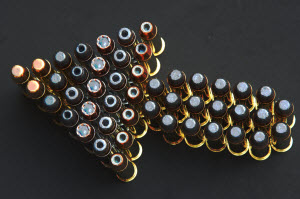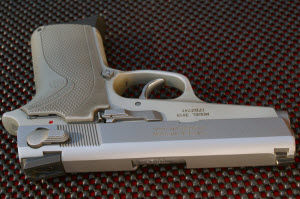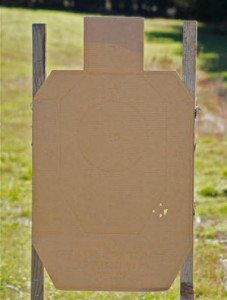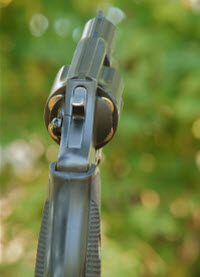If you’ve been around shooting for any length of time, you’ve encountered at least one member of the “Gun of the Month Club.” That’s the term used to describe the guy who carries or competes with a different gun every time he goes out.
One time it’s a Glock, the next it’s an XD, and after that … well, it’ll be whatever is on the cover of his favorite gun magazine that month. With a constantly changing manual of arms, folks like this never develop proper skills with the gun they claim to trust with their lives. The problems with carrying a different piece every other day are pretty obvious, except to the hapless soul who is so afflicted!
This desire to tote the newest thing on the block isn’t limited to hardware. There are members of the “Bullet of the Month Club” who do the same thing with ammunition.

There are many bullet types that you can load in your gun. Don’t let advertisements or magazine articles push you from one to another.
The worst part of this affliction? By constantly changing bullets, these folks aren’t making themselves any safer—in fact, it may be quite the opposite.
Problems: Reality
Everything starts, or should start, with reliability. It doesn’t matter how good a shot you are, how fast you can draw, or how many inches of ballistic gelatin your round penetrates if your gun doesn’t work.
Autoloading pistols can be sensitive to small variations in cartridge length, bullet shape, bullet nose length, weight, velocity, and even the differences among plated, unplated, and aluminum cases. If you want to know for certain that your gun will properly feed, fire, extract, and feed another round, it’s necessary that you test any new load thoroughly. It’s the only way to make sure that the system of gun, shooter, and ammunition will in fact perform on demand.
By “thoroughly,” I don’t mean a magazine of ammo through the gun! It’s necessary to shoot sufficient rounds to know, without doubt, that the gun will run with that specific load.

Changing ammo requires testing. If you’re using an autoloader, running a minimum of 100 rounds through the gun is highly recommended—and expensive!
If you adopt even the minimum testing regimen, it still adds up to a lot of ammunition to buy and shoot every time you change loads! At the price of defensive ammunition these days, the damage to the pocketbook is significant.
(Revolver owners have it a little better, as just a few cylinders are generally enough to make sure of ignition reliability. You still need to test, just not as extensively.)
Until you’ve personally verified the ammunition’s reliability, you don’t know if that new super-duper dragonslayer load will actually work in your gun. If it doesn’t, what advantage will it have? Changing ammunition for something more “effective” that renders your gun completely ineffective is not a recipe for success!
Problems: Sights
You have to make sure that the ammunition functions in your gun, but you also need to make sure it shoots where you expect it to!
Very few defensive guns boast fully adjustable (windage and elevation) sights, and will not shoot every single load to point-of-aim. There will very likely be differences in elevation between loads, and I’ve witnessed unexplained discrepancies in windage, too.

If you’re aiming for center-of-mass and your group is hitting low-right (or anywhere else), your ammo and sights don’t agree. One of them has to change.
The courses of action are to a) adjust your sights to match the load you’re shooting, or b) find a load that shoots to the same point as your sights. Don’t neglect this! Shooting with a gun whose sights don’t accurately predict where the bullet is going to land isn’t the most efficient method of ending a fight.
If your gun has fixed sights, like many revolvers and subcompact autoloaders, they can’t be easily matched (“regulated”) for every load. Regulating these sights for a particular load means actual physical changes to the gun, which may not always be easy or cheap to do. Again, if you don’t regulate those sights, you’ll have to remember where the gun is shooting. It’s better to find the load that shoots to the sights!
Isn’t There a Benefit?
Those are the downsides. Is there an upside? Some would say it’s important to seek out the best, the most effective ammunition, to protect their lives and the lives of their loved ones. Not doing so, the argument goes, is settling for second best.
That would be true if there were significant differences among competing ammunition. In reality, there isn’t any solid evidence that one bullet truly outperforms another of similar construction.
If we’re comparing modern hollowpoint ammunition from major manufacturers (which is the only thing you should be carrying, in my opinion), there doesn’t appear to be a huge performance advantage to any given load. There may be small differences in specific performance criteria from bullet to bullet, but overall equivalent loads from different companies are going to produce substantially the same end result.
Getting beyond the hype, a defensive round only needs to do two things. First, it has to reach something the attacker’s body finds immediately important; second, it has to do rapid and significant damage once it gets there. While it’s expected that bullet makers will tout the advantages of their exclusive designs, the fact is that just about any modern hollowpoint design will do both of those things on a pretty regular basis.
Worrying about an isolated factor of ammunition performance, such as deciding whether or not you should change to a new type of ammo because it has a bonded bullet and your current ammunition doesn’t, is just a waste of your time (and money.) The chances are extremely high that the new stuff isn’t going to do anything your current load won’t.
One thing’s for sure: It will be more expensive!

Many revolvers, like this Colt, have sights that aren’t user adjustable. Adjusting them to point to where the ammunition is actually hitting can be an expensive undertaking.
What To Do?
Call me a Luddite if you will, but my motto is “Stick with what works.” Pick a modern hollowpoint load, from a major manufacturer, that proves itself to be reliable in your gun. Have the sights regulated properly (or pick the load that shoots to point of aim), and just use it.
Spend the money you save on practice ammunition. Better yet, spend it on training! Learning to deliver rapid multiple combat-accurate hits on target under realistic conditions is far more important than an extra tenth of an inch in bullet expansion.
Constantly switching between different bullets gains you nothing, and in a critical incident may cost you more than just money. Find what works in your gun, and stick with it!
i wish to cancel my my yearley member ship with pdn please cancel me out r.m.e.
After some experimentation, I found a reasonably-inexpensive FMJ round with the same ballistic characteristics as my preferred hollow point. At the range, I shot the hollow point at three distances. I then tried a couple of different less-expensive FMJ bullets until I found one that landed and grouped very closely to what I shot with the hollow points. I can now shot the FMJ for practice and feel confident that the rounds are behaving comparably to my personal defense rounds.
Do you have any suggestions for finding a load that will shoot in every day carry gun? I carry a Colt 1911 MK IV that has point of impact low when I align sights properly. I can consistently compensate at the range but have never had to shoot my EDC in a life or death situation. I too like guns and have collected many. I prefer Colt 1911 and have a few. My full size shoots to correct height with same sight picture as EDC officer. I do shoot all of my pistols regularly. But I am still searching for the perfect defense round to correspond to the sights of my EDC.
What ammo? I don’t know where you live but in south and central Illinois your lucky to find a box of 9mm, 40, or 45 acp! You definitely don’t get several different brands to choose from! Number two because ammo has dried up I am reluctant to fire 200 rounds! Hope things open up soon so we can get to putting lead down range! Respectfully.
I'm interested
I completely agree with your logic. That being said, I have to admit that it is kind of fun to experiment with new and different rounds just to see IF there is actually any difference. I also have to agree with BigMickey that you should be willing to take advantage of advances in technology, again, if it truely is an advance and not just smoke and mirrors. As far as your "gun of the month club" comment in the first paragraph. I have several different handguns and rifles, partially because I like to collect different models, but also because I like to practice and become proficient with different models and calibers. All things considered though, I generally agree with everything you said in the article. I firmly believe that you should pracice and train with your primary firearm a lot, and you should train with the ammunition you intend to use. If you want to use a different gun or ammunition every time you go to the range just to play around and experiment that's fine, just remember to practice consistently with the same gun/ammo combination that you actually carry with you.
I have had a harder time trusting an organization - too much - that went with a 10mm gun over a .45 ACP. However, I found their advice on .38 rounds proved true and worthy. So I stick with Remington 158 gr. LSWCHP +P and on the fancy side, have some Speer 125gr. +P in a few speedloaders. My hits are better with Remington out of all the ammunition I've shot with my revolvers, save for for CCI WMR in the .22Mags. On that note, the best .357 round is still the 125gr. JHP - I use both Remington (best shooter) and Winchester. Sure that Federal equivalents are fine in either of the aforementioned calibers, we just don't see it as much around here on the shelves. However, in bear country this year, resorted to a heavy 180gr. .357 round as backup. So, yeah, after beating myself up over this issue, Grant's logic holds true from personal experience. Stick with the basics if you can do so.
The only time I've fallen into the BOTMC trap was when I've purchased a gun in a caliber I haven't used before, to wit a .357 SIG. I tried several rounds and all of them worked well and were reliable but I finally settled on the same round the DPS troopers are issued: Federal Premium 357 Sig 125 gr. JHP. Unfortunately, the ammo is very hard to find in quantify and very expensive (about $50/BX). Since the pistol was also tearing my hands up at about 50+ rounds and on, I finally traded it off for a Para Ord 14-45 and a Llama MiniMax .45 and went back to my old standby Federal Hydrashok. I appreciated your article and generally agree with you, except insofar as being seemingly unwilling to take advantage of an advance in technology -- assuming, of course that it is a true advance.
Why not use the testing budgets of the F.B.I., and Police to your advantage? They test extensively, and pick their loads, based on such testing. .40sw 180 grain Winchester Ranger/SXT. or PDX., and F.B.I. favorite, the powerful and effective,- .45acp 230grain Federal Hydrashock, are examples of these.
You're kidding, right? If I may be so bold: https://www.grantcunningham.com/2008/05/self-defense-stopping-power-and-caliber-part-7/ The whole series is relevant, and gives some important information about ammunition selection, but that article addresses all of the nonsense claims specifically. I didn't write it with Extreme Shock in mind, but it fits perfectly. Here's a link to the the series index: https://www.grantcunningham.com/2008/05/series-index-self-defense-stopping-power-and-caliber/ (Just a personal rule of thumb: if an ammunition company that I've never heard of is advertising their product using pictures of some amorphous "special forces/SWAT/ninja" team and silly product attributes like "fang face", it's probably not something on which I want to stake my life. Just a thought.) -=[ Grant ]=-